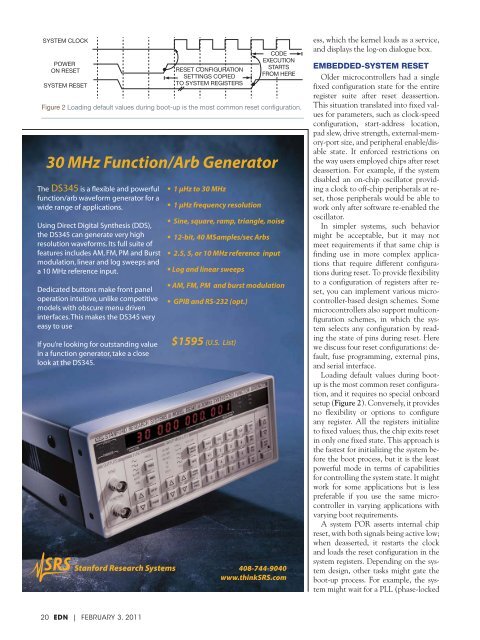VOICE OF THE ENGINEER - ElectronicsAndBooks
VOICE OF THE ENGINEER - ElectronicsAndBooks
VOICE OF THE ENGINEER - ElectronicsAndBooks
- No tags were found...
You also want an ePaper? Increase the reach of your titles
YUMPU automatically turns print PDFs into web optimized ePapers that Google loves.
SYSTEM CLOCKPOWERON RESETSYSTEM RESETRESET CONFIGURATIONSETTINGS COPIEDTO SYSTEM REGISTERSCODEEXECUTIONSTARTSFROM HEREFigure 2 Loading default values during boot-up is the most common reset configuration.30 MHz Function/Arb GeneratorThe DS345 is a flexible and powerfulfunction/arb waveform generator for awide range of applications.Using Direct Digital Synthesis (DDS),the DS345 can generate very highresolution waveforms. Its full suite offeatures includes AM, FM, PM and Burstmodulation, linear and log sweeps anda 10 MHz reference input.Dedicated buttons make front paneloperation intuitive, unlike competitivemodels with obscure menu driveninterfaces. This makes the DS345 veryeasy to use.If you’re looking for outstanding valuein a function generator, take a closelook at the DS345.• 1 μHz to 30 MHz• 1 μHz frequency resolution• Sine, square, ramp, triangle, noise• 12-bit, 40 MSamples/sec Arbs• 2.5, 5, or 10 MHz reference input• Log and linear sweeps• AM, FM, PM and burst modulation• GPIB and RS-232 (opt.)$1595 (U.S. List)Stanford Research Systems 408-744-9040www.thinkSRS.comess, which the kernel loads as a service,and displays the log-on dialogue box.EMBEDDED-SYSTEM RESETOlder microcontrollers had a singlefixed configuration state for the entireregister suite after reset deassertion.This situation translated into fixed valuesfor parameters, such as clock-speedconfiguration, start-address location,pad slew, drive strength, external-memory-portsize, and peripheral enable/disablestate. It enforced restrictions onthe way users employed chips after resetdeassertion. For example, if the systemdisabled an on-chip oscillator providinga clock to off-chip peripherals at reset,those peripherals would be able towork only after software re-enabled theoscillator.In simpler systems, such behaviormight be acceptable, but it may notmeet requirements if that same chip isfinding use in more complex applicationsthat require different configurationsduring reset. To provide flexibilityto a configuration of registers after reset,you can implement various microcontroller-baseddesign schemes. Somemicrocontrollers also support multiconfigurationschemes, in which the systemselects any configuration by readingthe state of pins during reset. Herewe discuss four reset configurations: default,fuse programming, external pins,and serial interface.Loading default values during bootupis the most common reset configuration,and it requires no special onboardsetup (Figure 2). Conversely, it providesno flexibility or options to configureany register. All the registers initializeto fixed values; thus, the chip exits resetin only one fixed state. This approach isthe fastest for initializing the system beforethe boot process, but it is the leastpowerful mode in terms of capabilitiesfor controlling the system state. It mightwork for some applications but is lesspreferable if you use the same microcontrollerin varying applications withvarying boot requirements.A system POR asserts internal chipreset, with both signals being active low;when deasserted, it restarts the clockand loads the reset configuration in thesystem registers. Depending on the systemdesign, other tasks might gate theboot-up process. For example, the systemmight wait for a PLL (phase-locked20 EDN | FEBRUARY 3, 2011345_HI4C.indd 112/21/2010 3:04:58 PM






![[270].pdf 37407KB Sep 02 2010 09:55:57 AM - ElectronicsAndBooks](https://img.yumpu.com/50350834/1/185x260/270pdf-37407kb-sep-02-2010-095557-am-electronicsandbooks.jpg?quality=85)
![draaien, A Viruly 1935 OCR c20130324 [320]. - ElectronicsAndBooks](https://img.yumpu.com/49957773/1/190x252/draaien-a-viruly-1935-ocr-c20130324-320-electronicsandbooks.jpg?quality=85)



![20051110 c20051031 [105].pdf 35001KB Feb 18 2009 08:46:32 PM](https://img.yumpu.com/48687202/1/190x253/20051110-c20051031-105pdf-35001kb-feb-18-2009-084632-pm.jpg?quality=85)




